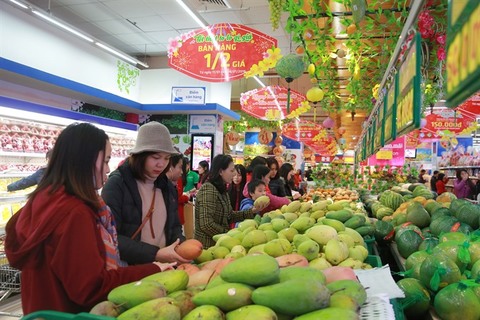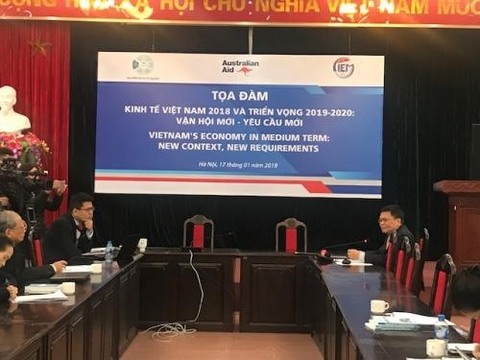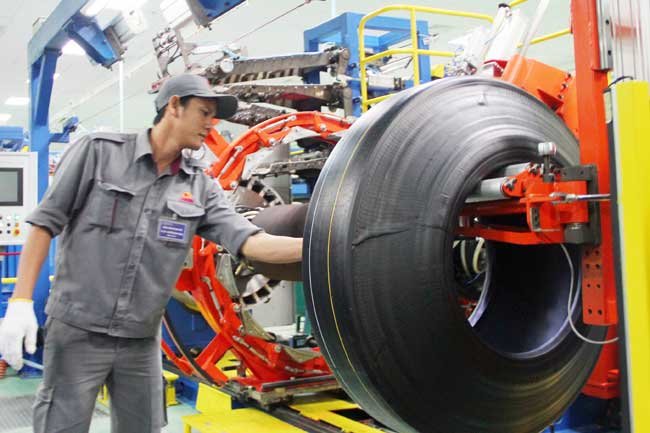Online-offline mix the new way to go
Online-offline mix the new way to go
With its crusade to renew itself to meet customers’ growing demand, businesses must balance online and offline sales and incorporate a full range of services seamlessly.
Catching up with new trends, Lazada Supermarket has just been launched on Lazada.vn last week to offer essential goods at competitive prices, and expects to become the largest online supermarket in Vietnam and Southeast Asia. Under this supermarket system, Lazada will maintain a warehouse for its vendors’ goods where it can inspect quality and vendors’ certifications.“To put concerns over increasing prices and fake goods to bed, customers can now pick up authenticated essential goods from Lazada Supermarket. This will help them enjoy safe shopping while saving time on going to real stores and supermarkets,” said Tran Thi Hoang Uyen, director of Fast Moving Consumer Goods of Lazada Vietnam.
“Lazada Electronic City and Lazada Supermarket are part of Lazada’s long-term development strategy in Vietnam to bring diversified products from leading local and international brands. In the near future, we will develop these two online stores to become the leading destination for all consumers by shortening purchase times while continuously increasing the number of products and brands. For Lazada Supermarket, we set the goal to become the largest online supermarket in Vietnam and Southeast Asia,” said Max Zhang, CEO of Lazada Vietnam.
However, Lazada is not the first e-commerce supermarket. Tiki.vn and Shopee.vn have also been making moves in the market for a year or so.
Talking with VIR about this new model, a Lazada representative said that the quality of every item on Lazada Supermarket is guaranteed. The items are stored in Lazada’s warehouses and delivered to customers in 10 cities and provinces for free. “The list of cities and provinces where delivery is free will be expanded in the near future,” he added. “With the application of Artificial Intelligence and Big Data analytics, Lazada could personalise the purchasing process for individual customers on its platform, to provide the best shopping experience as well as recommend high-quality items in the searching tool and customers’ homepage.”
Retail titans see further growth
Even two of the world’s largest e-commerce giants Amazon and Alibaba are looking to break into ‘real’ retail. Amazon opened its first book store three years ago in the US’ Seattle, followed a year later by Alibaba in China. These stores increase costs and reduce profit, however, they also serve as experience spaces to link retailers and customers. This shows that the combination of online and offline retail is emerging as a key solution among retailers.
In the last two years, Jack Ma, the owner of Alibaba, has been pioneering this new retail model. Alibaba has conducted a lot of deals in the traditional retail segment, including a buy-in to Suning.com, one of the largest non-government retailers in China, and the acquisition of the Intime department store chain.
Meanwhile, Amazon released a new shopping concept called “Treasure Truck,” which combines online and offline methods, and has deployed it across the US. This confirms that businesses see further growth and sustained development in this direction, where they can earn from e-commerce platforms and use stores as experience spaces to provide hands-on experience to lure in customers.
Online-offline combo
According to HSBC, one of the largest banking and financial services institutions in the world, Vietnam has been emerging as a “dragon” in the retail segment.
According to the Vietnamese government’s master plan by 2020, there will be around 1,200-1,500 supermarkets, 180 trade centres, and 157 shopping centres in locations throughout the country. Meanwhile, according to the General Statistics Office, total retail sales and consumer service revenue in 2018 is estimated at nearly VND4.4 quadrillion ($191.3 billion), up 11.7 per cent on-year.
Notably, technology has been altering consumer behaviour. The results of PwC’s survey on the retail market showed that 49 per cent of consumers make purchases via their smartphone at least once a month.
This trend enables retailers to shift to online sales and learn about consumer behaviour to improve performance and save costs. E-commerce is an inevitable trend in the retail industry not only in Vietnam, but also over the globe.
Currently, supermarket and convenience store chains are paying more attention to online-to-offline (O2O) solutions to salve the pressure from hundreds of e-commerce platforms operating in Vietnam.
Last October, Auchan Retail Vietnam, one of the leading retailers in Europe, and Lazada Vietnam signed a memorandum of understanding on strategic co-operation with regard to the launch of their O2O model. Accordingly, customers could visit Auchan’s online store on Lazada.vn featuring thousands of high-quality authenticated goods and hundreds of private label products.
“Some 2,000 orders have been made after two months of operation. Moreover, items from Auchan have received positive feedback from Vietnamese customers, most of whom gave the shop four or five stars,” Nguyen The Dong, digital director of Auchan Retail Vietnam, told VIR.
O2O helps in-store purchases
Numerous other supermarkets have been deploying online sales. For example, VinMart can now be accessed from Adayroi.com, which is Vingroup’s e-commerce platform, while Co.opmart developed its own private website. Others like AEON, Lotte Mart, and 7-Eleven have all created smartphone apps.
Jeong Seong Won, chief financial officer of Lotte Vietnam Shopping JSC, told VIR about the Lotte app, saying that the first results are very positive, with the value of each order from the app being around VND500,000 ($21.7), much higher than the VND200,000 ($8.7) customers usually spend in person at the stores. Meanwhile, the number of customers making purchases on their smartphones has doubled every month.
“In the future, we are going to pour $50 million into e-commerce development in Vietnam,” Won said.
Meanwhile, according to the representative of 7-Eleven, there are a multitude of ways to apply the O2O model in the retail segment. For example, using the app of this convenience store chain, customers will get one drink for free after ordering six drinks through the app, which they can pick up at the shop in person, where they can buy other items. This means the app can increase revenue from walk-in customers.
Earlier, in 2016, Nguyen Kim Trading JSC, one of the leading electronics retailers and whose 49 per cent stake is held by Thai conglomerate Central Group, acquired Zalora.vn, an e-commerce fashion platform. However, the company seems rather sluggish in its application of the O2O model in its retail chain.
Talking about the challenges faced with this model, retail expert Tran Anh Tuan said, “Last mile delivery is a key part of retail supply chains, and businesses need to forge seamless collaboration between offline and online operations to provide the best services. The wide coverage of local retailers is one of their advantages, but with their rich experience, foreign players will likely do better and step faster in the O2O race.”
Retail experts said that multi-channel sales, including online and offline, have become an inevitable trend in Vietnam, contributing to the development of the e-commerce segment to reach the $10 billion forecasted by experts by 2020.
Under statistics of the Vietnam E-Commerce Association, O2O retail is one of the most spectacularly growing segments in e-commerce, growing 35 per cent in 2017, a whopping 10 per cent higher than the whole Vietnamese e-commerce industry.


















